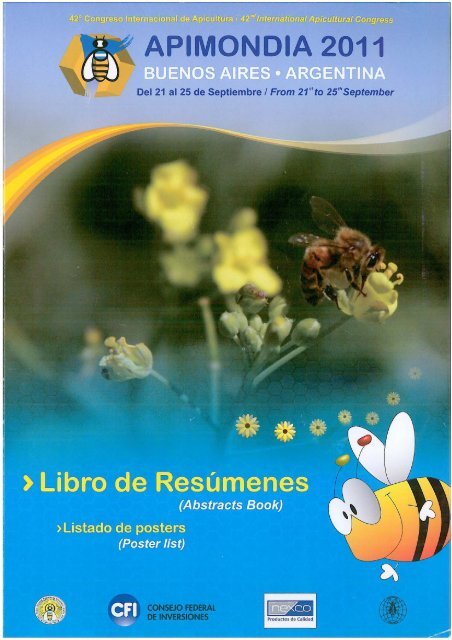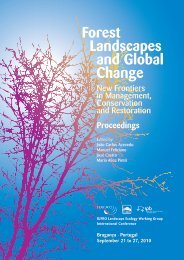APIMONDIA 2011 - Biblioteca Digital do IPB
APIMONDIA 2011 - Biblioteca Digital do IPB
APIMONDIA 2011 - Biblioteca Digital do IPB
You also want an ePaper? Increase the reach of your titles
YUMPU automatically turns print PDFs into web optimized ePapers that Google loves.
<strong>APIMONDIA</strong> <strong>2011</strong><br />
Del 21 al 25 de Septiembre I From 21st to 25th September<br />
CONSEJO FEDERAL<br />
DE INVERSIONES
41) Martin Giurfa - France (IS)<br />
HONEY BEE LEARNING IN A SOCIAL CONTEXT: MODULAT ION OF APPETITIVE LEARNING BY AN<br />
10:00- 10:40 ALARM PHEROMONE<br />
42) Waiter Farina - Argentina<br />
PAST EXPERIENCES ORGANIZE SOCI AL BEHAVIOR IN HONEYBEES: BASIC KNOW LEDGE AND<br />
11:20- 12:00 APPLICATION FIELDS<br />
431 Michael Hrncir - Brazil (IS)<br />
EFFICIENT FOOD EXPLOITATION BY STINGLESS BEES (MELIPONA SEMINIGRA):<br />
12:00 - 12:20 IS T HE RECRUITMENT OF NA IVE FORAGERS REALLY IMPORTANT?<br />
44) Mark Kerry Greco - United King<strong>do</strong>m<br />
ASSESSING DECISION M AKING IN STORER HONEYBEES USING DIAGNOSTIC RADIOENTOMOLOGY:<br />
12:20- 12:40 DO HONE YBE ES EXHIBIT OPTIMAL STORAGE STRATEGIES?<br />
45) Karl Crailsheim - Austria<br />
12:40- 13:00 TROPHALLAXIS OF NURSE BEES (AP/S MELLIFERA L.}<br />
p.146<br />
p.146<br />
p.147<br />
p .147<br />
p.148<br />
SATURDA V 24 - ROOM AFRICA<br />
SYMPOSIUM: Nutrition and physiology - 9:00 to 10:40<br />
Chair: Karl Crailsheim - Austria<br />
46) Victor Hugo Franco Olivares- Mexico<br />
RESPONSE OF THE USE OF SUPPLEMENTS OF POLLEN ON THE PATTERNS OF PRODUCTIVITY IN<br />
09:00 - 09:20 POSITION AND THE BEE HIVE (APIS MELLIFERA)<br />
471 Jozef Simuth- Slovakia<br />
09:20 - 09:40 QUEEN HONEY BEE LONGEVITY, AGING AND ROYAL JELLY PROTEINS: ~AV E WE MOVED FORWARD?<br />
48) Jozef Van der Steen - Netherlands<br />
0 9:40 - 10:00 VITELLOGENIN AS A PARAMETER OF HONEY BEE CO LONY FITNESS<br />
49) Marina Basual<strong>do</strong> - Argentina<br />
NATURAL POLLEN DIETS AND THEIR EFFECT ON FAT BODY WEIGHT AND PROTEIN<br />
10 :00 - 10:20 CONCENTRATION<br />
50) Vasyl Gaidar - Ukraine<br />
10:20 - 10:40 CARPATHIAN BEES OF UKRAINE<br />
p.148<br />
p.149<br />
p . 149<br />
p.149<br />
p.150<br />
SYMPOSIUM: Biodiversity and Conservation - 11 :20 to 13:00<br />
Chair: Lionel Goncalves - Brazil<br />
51 ) Vera Lucia lmperatriz Fonseca - Brazil (IS)<br />
11 :20 - 11 :40 SUSTAINABLE USE AND CONSERVATION OF NATIVE POLLINATORS IN BRAZIL<br />
52) Maria Alice Pinto - Portugal<br />
PATTERNS OF GENETIC VARIATION OF APIS MELLIFERA IBERIENSIS: INSIGHTS FROM THE<br />
11 :40 - 12:00 POPULATIONS INHABITING THE ATLA NTIC SIDE OF THE IBERIAN PENINSULA<br />
53) Maria Constanza Vidal Montero - Chile<br />
ANALYSIS OF THE GENET IC STRUCTURE OF BEES IN CHILE: IDENTIFICATION OF AFRICANIZED<br />
12:00 - 12:20 BEES USING MITOCHONDRIAL DNA<br />
54) Juan Marcos Juricich - Argentina<br />
LOOKING FOR DRONES FREE AREAS FOR NATURAL FECUNDATION OF QUEEN BEES, VALLECITOS,<br />
12:20- 12:40 LUJAN, MENDOZA , ARGENTINA<br />
55) Tiago Mauricio Francoy - Brazil<br />
JOINING LANDMARK AND OUTLINE-BASED METHODS IS MORE EFFICIENT IN DISCRIMINATING<br />
12:40 - 13:00 EUGLOSSA SPECIES<br />
p. 150<br />
p . 151<br />
p.151<br />
p . 151<br />
p.152<br />
BEE HEALTH COMMISSION<br />
FRIDA V 23 - ROOM ASIA - 9 :00 to 13:00<br />
PLENARY SESSION: Strategies to improve honeybee health<br />
Chair: Wolfgang Ritter - Germany<br />
56) Wolfgang Ritter - Germany<br />
09:00-09:20 UPDATE ON BEE DISEASES<br />
57) Jeff Pettis - United States (IS)<br />
09:20 - 10:00 A RETROSPECTIVE LOOK AT FACTORS CONTRI BUTING TO COLONY LOSSES IN THE U.S. OVER FIVE YEARS<br />
58Jngemar Fries - Sweden (IS)<br />
10:00 - 10:20 CAN WE MODEL HONEY BEE H EALTH ?<br />
59) Robin Moritz - Germany (IS)<br />
10:20 - 10 :40 MODERN GENETICS A ND BREEDING FOR COLONY HEALTH<br />
60) Tjeerd Blacquiere - Netherlands<br />
11:20 - 11 :40 SEMI NATURAL SELECTI ON FOR VARROA TOLERANCE USING AN ISLAND FOR M ATING<br />
p.152<br />
p.153<br />
p. 153<br />
p.154<br />
p.154<br />
11 8
PATTERNS OF GENETIC VARIATION OF APIS MELLIFERA /BERIENSIS: INSIGHT$ FROM<br />
THE POPULATION$ INHABITING THE ATLANTIC SIDE OF THE IBERIAN PENINSULA<br />
Maria Alice Pinto - Portugal<br />
Pinto, M.A 1; Mufwz, 12; Ne to, M.l; Cuedes, H. I ; Calarza, }.I; Souza, L3.; Pi res, SI.; De la Rua, P.2<br />
I Mountain Research Centre (Cl MO), Polytechnic Institute of Bragan~a. Campus de Sta. Apo16nia, Aparta<strong>do</strong> 1172,<br />
5301-855 Bragan~a. Portugal, apinto@ipb.pt<br />
2Area de Biologia Animal, Opto. de Zoologia y Antropo/ogia Fisica, Facultad de Veterinaria, Universidad de Murcia,<br />
Campus de Espinar<strong>do</strong>, 30100 Murcia, Spain<br />
3Universidade Federal <strong>do</strong> Rec6ncavo da Bahia, Bahia, Brazil<br />
The Iberian honey bee, Apis mellifera iberien sis, has been one of the most intensively surveyed honey bee<br />
subspecies for genetic variation. Despite the numerous studies, the maternal composition of the populations<br />
inhabiting the Atlantic side of the Iberian Peninsula was virt ually unknown until recently. Between 2009 and<br />
2010 we sampled over 1000 colonies across continental Portugal, which were then examined using the Oral<br />
RFLP of the cox 1-cox2 mitocondrial DNA marker. Our f indings show (i) a high genetic diversity mostly of<br />
African origin (A lineage), as expected; (ii) a north- south cline formed by sublineage Alii which is gradually<br />
replaced by sublineage AI; (iii) haplotypic variation never reported before; (iv) a low frequency of colonies<br />
belonging to lineage M; (v) a low level of genetic pollution from C lineage (Italian and Carniola honey bees).<br />
This study provides a fuller picture of the Iberian honey bee evolutionary and contemporary history and<br />
at the same time supply baseline information that can be of further use for development of breeding and<br />
conservation programs of honey bees in Portugal.<br />
---.. ANALYSIS OF THE GENETIC STRUCTURE OF BEES IN CHILE:<br />
IDENTIFICATION OF AFRICANIZED BEES USING MITOCHONDRIAL DNA<br />
Maria Constanza Vidal Montero - Chile<br />
Vidal, MC. I; Garnery, L. 2,3; Legoux, H.2<br />
1 Servicio Agricola y Canadero (SAG), Subdepartamento Laboratorios y Estaci6n Cuarentenaria<br />
Pecuaria, Laboratorio de Parasitologia Pecuaria, Kil6metro 12, Ruta 68, Pudahuel, Santiago, Chile.<br />
Phone: 56·2-3451913, Fax: 56-2-3451903, email: constanza.vidaf@sag.gob.cl.<br />
2 CNRS, Laboratoire Cemitique, Evolution et Speciation, Avenue de la Terrasse 91198 Cif-sur, Yvette,France.<br />
Phone: 33-1-6982 3718, Fax: 33· 1-6982 37 36, email: Lione/.Garnery@legs.cnrs- gif.fr, Helene.Legout@legs.cnrs-gif.fr.<br />
3 University of Versailles-Saint-Quentin-en· Yvelines, 45 Avenue des Etats-Unis 78035, Versailles, France.<br />
Africanized bees are a hybrid between European honey bees and African honey bees. They are characterized<br />
by being more aggressive, aban<strong>do</strong>ning hives, invading the hives of European bees, and by forming swarms.<br />
In addition to being complicated for beekeepers to handle and signifying a risk for humans, they also pose a<br />
ri sk to biodiversity. To date, there have been no systematic, scientific studies that investigate the presence<br />
of Africanized bees in Ch ile, even though they have been reported in the countries with whi ch it shares<br />
borders. The objective of this paper, then, is to analyze the genetic structure of a sample of the Chilean<br />
honey bee population by studying polymorphism in the intergenic region CO l-CO li of the mitochondrial<br />
DNA (mtDNA) in order to detect Africanization. With this ai m, 436 samples from four reg ions in the North<br />
and Ce nter of the country were analyzed. By using PCR-RFLP in 7.5% acrylamide gel and the Oral restriction<br />
enzyme, the lineage and haplotypes of each sample were determined. Among the resu lts obtained,<br />
the lineages C and M, and the haplotypes Cl, C2, C3, M3 , M?, and M17 were distinguished. Thes e resu lts<br />
indicate that there has been no Africanization in the maternal line of the population studied, its origin being<br />
European. The places from which the bees could have been imported include Italy, Northern France and<br />
the Caucasus region of central Europe, as these are the geographic areas that present the same haplotypes<br />
as those determined in this study. In accordance with this, in the future it wi ll be relevant to confirm these<br />
results by am plifying the analysis to study nuclear DNA through microsatellite markers.<br />
LOOKING FOR DRONES FREE AREAS FOR NATURAL FECUNDATION OF QUEEN BEES,<br />
VALLECITOS, LUJAN, MENDOZA, ARGENTINE<br />
juan Marcos juricich -Argentina<br />
lng. Agr. juan Marcos )uricich I , Tee. Diego Lema2 Tee. Roque Heredia3<br />
I Facultad de Ciencias Agrarias, Universidad Nacional de Cuyo, Almirante Brown 500, Chacras de Coria, Men<strong>do</strong>za.<br />
Republica Argentina. tel. 54(261 ) 41 350 10 int 123 1 email: )uricich@fca.uncu.edu.ar<br />
2 Asociaci6n Men<strong>do</strong>cina de Cria<strong>do</strong>res de Abejas Reinas, tel. 54(2627) 438323 amcar.correo@gmail.com<br />
3 Liceo Agricola y Enol6gico "Oomingo Faustino Sarmiento", Universidad Nacional de Cuyo, Av. San Francisco de Asfs s/ n.<br />
tel. 54(261) 42811 33 email: roqueheredia@gmail.com<br />
1 51

















